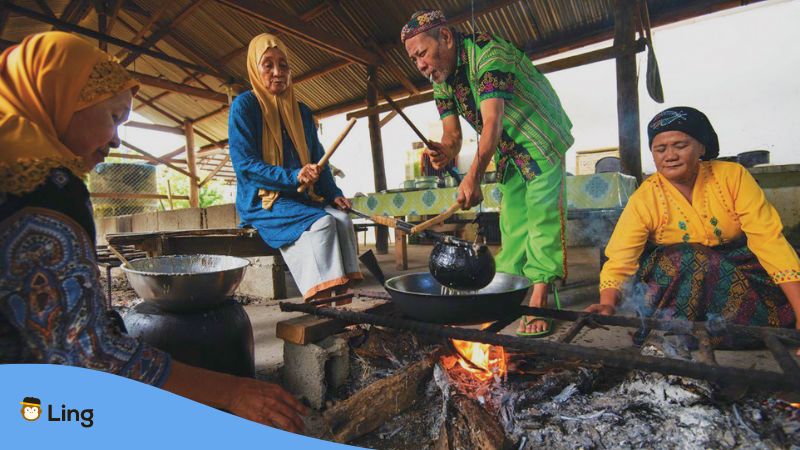Interested in finding out how the locals create your favorite tsibog (slang for food)?In this post, we will walk you through the common Tagalog cooking terms you might encounter when conversing with the locals, especially when the topic is about pagkain (food in English).
Filipinos love eating, and it would be wise to learn Tagalog since cooking can be one of the many topics that will help you connect with the locals interestingly. In fact, speaking about cuisine might even get you to be invited to a salu-salo (feast)! Let’s get to know more about cooking vocabulary in Tagalog below.
Common Tagalog Cooking Terms
The Tagalog word for “cooking” is pagluluto, and this is one of the favorite things to do by Filipinos aside from eating. From almusal (breakfast) to tanghalian (lunch) to hapunan (dinner ), the locals’ kitchen is always busy. Want to know how to say ‘fry,’ ‘boil,’ and ‘roast’ in Tagalog? Great! In the table below, I will teach you some common cooking terms that will help you chat in Filipino kitchens.
I can see that you are very eager to learn the Tagalog language. In that case, why don’t you try using the Ling app? In just one week, your Tagalog language skills will grow while having fun with this language app. It’s totally free to use and download from Google Play and App Store. Now, let’s kick off and heat up your language skills!
Cooking Methods In Filipino Food
Filipino cooking uses many different cooking methods that show the country’s rich culture and ability to adapt. From smoky grilled dishes to steaming-wrapped foods, these cooking techniques highlight local ingredients while keeping old traditions alive.
Grilling (Pag-iihaw) – The Heart Of Get-Togethers
The sound of meat sizzling on a grill signals a fun time across the Philippines. Called ihaw, grilling gives food a tasty smoky flavor and brings people together at beach parties or backyard gatherings. Whole roasted pig lechon marks big Philippine festivals, while grilled chicken inasal, marinated in vinegar and spices, is a tangy local specialty.
Stewing (Paglalaga At Pagsisigang) – Comfort And Tradition
Warm, filling stews nourish Filipinos all over the islands. Beef, pork, and veggie nilaga simmer gently as a comforting homestyle dish. Meanwhile, sinigang, with its sour taste from tamarind, guava, or unripe mango, shows local flavors in this classic soup. Stewing makes the soul happy and connects to tradition.
Sautéing (Paggigisa) – Bringing Out Natural Goodness
The simple sautéing of garlic, onions, and tomatoes forms the flavor base for many favorite dishes like adobo, kaldereta, afritada, and menudo. This quick gisa technique brings out the natural taste of fresh ingredients. As a nod to Spanish influence, it remains a key step that makes Filipino food distinctly delicious.
Fermenting (Pagbuburo) – Preserving With Cleverness
Filipinos skillfully use fermentation to preserve seafood and make harvests last longer. In Central Luzon, like in Pampanga and Nueva Ecija, the specialty buro, fermented fish, or rice, honors old traditions and satisfies the cravings of the locals and even tourists. Sweet-sour pickled green papaya achara balances rich grilled meats. These clever methods add complexity to flavor and show the Filipino spirit of resourcefulness.
Wrapping And Steaming (Pagbabalot At Pagpapasingaw) – Natural Creativity
Wrapping foods in fresh banana leaves before steaming, called binalot and pasingaw, displays rural Filipino creativity and connection with nature. Rice cakes and fish come out infused with herb-like aromas. This green cooking for fiestas and village feasts honors the natural world through flavor and sustainable materials.

Common Ingredients For Cooking
Since you already know some of the most common cooking techniques in Tagalog, why not learn about the basic Tagalog ingredients Filipinos always use and add to their cooking? These are what truly bring Filipino dishes to life.
What Does Filipino Food Taste Like?
Flavorful spices here and there. Steamed rice wrapped in banana leaves. Charcoal-grilled seafood. These are some of the delicious cooked meals that almost all Filipinos will ask you to try out if you ever visit the country. Some of the locals call the country “a melting pot of flavors,” and the reason for that is that most of Filipino cooking styles has been influenced by other cultures, including Indian, Chinese, Indonesian, Spanish, and American.
If you are wondering what Filipino foods usually taste like, then allow us to be blunt here: Filipino food is very saucy and has a strong seasoning! This is very different from some of the Southeast Asian styles that usually involve large amounts of herbs.
In addition, Filipinos enjoy complex and time-consuming dishes like Paella, Bulalo, and Lechon. This is why you need to expect that Philippine restaurants sometimes take 15-30 minutes to almost an hour to serve these types of food.

What Makes Filipino Cooking Interesting?
Whenever one thinks of Filipino cooking, what foreigners usually crave are chicken/pork adobo, bagoong with mangang hilaw, sinigang, stuffed morcon, or maybe tapa and paksiw. However, these classic Filipino dishes remain the most popular ones since they have a unique, intriguing taste that is somewhat the same… yet different from the cuisines of neighboring countries.
Flavors Used By Filipinos
Usually, the flavors you can expect from the traditional Filipino food in the country are maanghang (spicy), maalat (salty), and maasim (sour). They also love adding coconut milk or gata in Tagalog when cooking since they enjoy ma-gatas (creamy) and masarsa (saucy) food paired with rice! In fact, they use this dairy-free milk substitute for cooking rice, making sweet popsicle treats, and concocting their own coconut ice cream!
Unique Exotic Foods In The Philippines
There are also exotic food selections that are only cooked in the Philippines, and not all individuals have an appetite for it! Some of the top exotic picks Filipinos have are balut (incubated duck eggs), butete tugak (deep-fried frogs), isaw ng manok (chicken intestines), betamax (grilled blood cubes), kinilaw na tamilok (woodworm dipped in vinegar and salt). Interesting set of food for thrill-seekers, don’t you think?
Now that we already know the flavor and interesting dishes that the country offers, you can now have ideas about what to cook next time you visit the Philippines. Use the Tagalog cooking terms you learned today to show your co-Filipino cook that you can cook Filipino dishes while showing your Tagalog language skills.
Conclusion
As we reach this part of the post, we hope that you were able to explore the exact Tagalog cooking terms usually used in Filipino cooking. With knowledge of these, you can now easily follow traditional recipes and even start a conversation about Filipino food and the common cooking styles of the locals.
Also, if you’d like to learn more about how you can improve or gain confidence in speaking Tagalog, we definitely recommend that you try the Ling app. See you there!
FAQs About Tagalog Cooking Terms
What are the common Filipino cooking methods?
Core to Filipino cooking is boiling, known as nilaga, grilling or ihaw, roasting and a unique steaming called halabos. These techniques represent tradition and align with healthier eating trends today.
What is Busa in cooking?
In Tagalog, busa refers to lightly roasting or toasting ingredients in a little oil. It’s often used for snacks like cashews, tiny fish (dilis), corn, and peanuts. A round-bottomed pan called a kawa or kawali is typically placed over an open fire, adding a signature toasty flavor.
What is the holy trinity of Filipino cooking?
At the start of many Filipino dishes is gisa, which means sautéing garlic (bawang) and onions (sibuyas). Adding tomatoes (kamatis) completes what is affectionately called the holy trinity of Filipino cuisine. This classic trio lays the tasty foundation for countless cherished dishes in the Philippines.
Updated By: Jefbeck



































































